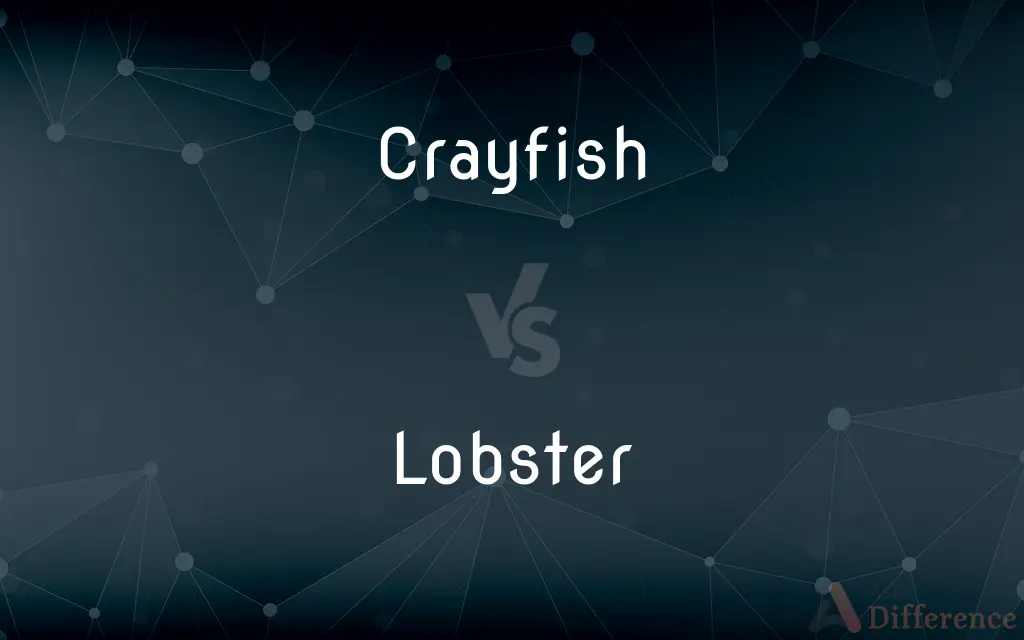Crayfish vs. Lobster — What's the Difference?
By Tayyaba Rehman — Updated on September 22, 2023
Crayfish is a Freshwater crustaceans resembling small lobsters. Lobster is marine crustaceans with large claws. While crayfish thrive in freshwater habitats, lobsters are primarily saltwater inhabitants.

Difference Between Crayfish and Lobster
Table of Contents
ADVERTISEMENT
Key Differences
Crayfish and lobster, at a first glance, might appear similar due to their exoskeletons and segmented bodies. However, there are distinguishing factors that set them apart. Crayfish, often referred to as crawdads or crawfish, predominantly reside in freshwater environments like rivers, streams, and ponds. They typically have a smaller stature, sometimes not exceeding a few inches in length. Lobsters, on the other hand, are marine creatures mostly found in oceans and seas.
The habitat difference between crayfish and lobster is a significant indicator of their respective biological needs and behaviors. Crayfish usually burrow into the substrate and are known to establish territories in freshwater bodies. Lobsters, in contrast, tend to roam the seafloor, and their larger size, especially in the case of the American and European lobsters, is evident with their massive claws, which crayfish lack in such prominence.
Another interesting distinction is their culinary value. While both crayfish and lobster are consumed worldwide, lobsters, especially from the North Atlantic, are often considered a delicacy and can fetch a higher price in the market. Crayfish, although popular in many regional cuisines, especially in the southern United States, are generally more accessible and affordable.
Color variations also occur between crayfish and lobster. Crayfish usually display earthy tones, blending with their freshwater environment. Lobsters, meanwhile, might range from dark blue-green to brown, turning a familiar bright red when cooked. Regardless of these differences, both crustaceans play vital roles in their ecosystems and contribute to the gastronomic delights of many cultures.
Comparison Chart
Habitat
Predominantly freshwater (rivers, streams, ponds)
Primarily marine (oceans and seas)
ADVERTISEMENT
Size
Generally smaller, often just a few inches
Larger, with some species growing over a foot
Culinary Value
More affordable, popular in regional cuisines
Often considered a delicacy, especially North Atlantic varieties
Claws
Less prominent claws
Larger, more pronounced claws
Coloration
Earthy tones
Dark blue-green to brown; turns red when cooked
Compare with Definitions
Crayfish
A small freshwater crustacean.
We caught a bucket full of crayfish during our trip to the creek.
Lobster
A large marine crustacean with massive claws.
The chef prepared a delicious grilled lobster for dinner.
Crayfish
An aquatic creature popular in Southern U.S. cuisine.
The crayfish boil was the highlight of the summer party.
Lobster
A decapod crustacean belonging to the family Nephropidae.
The marine biologist gave a lecture on the life cycle of the lobster.
Crayfish
A crustacean resembling a mini lobster.
The child was fascinated by the crayfish's tiny claws and segments.
Lobster
A highly prized seafood delicacy.
For our anniversary, we ordered lobster at the upscale restaurant.
Crayfish
Decapod crustaceans of the superfamilies Astacoidea and Parastacoidea.
Researchers were studying the behavior of several species of crayfish.
Lobster
A saltwater invertebrate found on the seafloor.
Divers spotted a lobster hiding beneath a rock ledge.
Crayfish
Crayfish are freshwater crustaceans resembling small lobsters (to which they are related). In some parts of the United States, they are also known as crawfish, craydids, crawdaddies, crawdads, freshwater lobsters, mountain lobsters, rock lobsters, mudbugs, or yabbies.
Lobster
A creature that turns red when cooked.
The blue-green lobster turned a vibrant red after being boiled.
Crayfish
Any of various freshwater crustaceans of the families Astacidae and Cambaridae of the Northern Hemisphere and the family Parastacidae of the Southern Hemisphere, resembling a lobster but considerably smaller. Also called mudbug; also called regionally crawdad.
Lobster
Lobsters are a family (Nephropidae, sometimes also Homeridae) of large marine crustaceans. Lobsters have long bodies with muscular tails, and live in crevices or burrows on the sea floor.
Crayfish
See spiny lobster.
Lobster
Any of several edible marine decapod crustaceans of the family Nephropidae, especially of the genus Homarus, having stalked eyes, long antennae, a pair of large pincers, and a cylindrical body.
Crayfish
Any of numerous freshwater decapod crustaceans in superfamily Astacoidea or Parastacoidea, resembling the related lobster but usually much smaller.
Lobster
Any of several similar crustaceans, such as a spiny lobster.
Crayfish
A freshwater crustacean (family Cambaridae), sometimes used as an inexpensive seafood or as fish bait.
Lobster
The flesh of a lobster used as food.
Crayfish
A rock lobster (family Palinuridae).
Lobster
To catch or try to catch lobsters.
Crayfish
(AU) A freshwater crayfish (family Parastacidae), such as the gilgie, marron, or yabby.
Lobster
Red-colored, especially from a sunburn.
Red as a lobster
Crayfish
(Singapore) The species Thenus orientalis of the slipper lobster family (Scyllaridae).
Lobster
A crustacean of the Nephropidae family, dark green or blue-black in colour turning bright red when cooked, with a hard shell and claws, which is used as a seafood.
Crayfish
To catch crayfish
Lobster
A crustacean of the Palinuridae family, pinkish red in colour, with a hard, spiny shell but no claws, which is used as a seafood.
Crayfish
(to backpedal, desert, or withdraw)
Lobster
A soldier or officer of the imperial British Army (due to their red or scarlet uniform).
Crayfish
See Crawfish.
Lobster
(slang) An Australian twenty dollar note, due to its reddish-orange colour.
Crayfish
Warm-water lobsters without claws; those from Australia and South Africa usually marketed as frozen tails; caught also in Florida and California
Lobster
To fish for lobsters.
Crayfish
Tiny lobster-like crustaceans usually boiled briefly
Lobster
Any large macrurous crustacean used as food, esp. those of the genus Homarus; as the American lobster (Homarus Americanus), and the European lobster (Homarus vulgaris). The Norwegian lobster (Nephrops Norvegicus) is similar in form. All these have a pair of large unequal claws. The spiny lobsters of more southern waters, belonging to Palinurus, Panulirus, and allied genera, have no large claws. The fresh-water crayfishes are sometimes called lobsters.
Crayfish
Small freshwater decapod crustacean that resembles a lobster
Lobster
As a term of opprobrium or contempt: A gullible, awkward, bungling, or undesirable person.
Crayfish
Large edible marine crustacean having a spiny carapace but lacking the large pincers of true lobsters
Lobster
Flesh of a lobster
Crayfish
Inhabitants of streams and ponds with burrowing tendencies.
The muddy banks of the pond were riddled with crayfish burrows.
Lobster
Any of several edible marine crustaceans of the families Homaridae and Nephropsidae and Palinuridae
Common Curiosities
Are crayfish and lobster the same?
No, while they might appear similar, crayfish are freshwater creatures and lobsters are marine.
Are crayfish also called crawfish?
Yes, crayfish are also referred to as crawfish, crawdads, and mudbugs.
How can I differentiate between crayfish and lobster?
Check the habitat; crayfish are freshwater, while lobsters are marine. Also, lobsters are generally larger with pronounced claws.
Are crayfish popular in international cuisines like lobster?
Crayfish are popular in many regional cuisines, while lobsters have a broader international appeal.
Can crayfish be eaten like lobster?
Yes, crayfish are popular in many cuisines, especially in the southern U.S.
Do crayfish and lobster taste the same?
While both are crustaceans, their flavors can vary due to differences in habitat and diet.
Are both crayfish and lobster safe to eat?
Both are safe to eat when properly sourced and cooked.
Which is bigger, crayfish or lobster?
Lobsters are generally larger than crayfish.
Why do lobsters turn red when cooked?
The heat breaks down proteins, releasing a carotenoid pigment, turning the lobster red.
Which is more expensive, crayfish or lobster?
Lobsters, especially from the North Atlantic, are typically more expensive.
How do crayfish defend themselves compared to lobsters?
Both can use their claws for defense, but lobsters have larger and more powerful claws.
How long can lobsters and crayfish live?
Some lobsters can live up to 50 years or more, while crayfish generally live up to 3-8 years.
Do crayfish and lobster both turn red when boiled?
While lobsters turn red when cooked, crayfish might not always display such a pronounced color change.
Do both crayfish and lobster belong to the same biological family?
No, crayfish belong to superfamilies Astacoidea and Parastacoidea, while lobsters belong to the family Nephropidae.
Can you keep crayfish as pets, like some do with lobsters?
Yes, many people keep crayfish in aquariums as pets.
Share Your Discovery

Previous Comparison
Actual vs. Virtual
Next Comparison
Single vs. WidowedAuthor Spotlight
Written by
Tayyaba RehmanTayyaba Rehman is a distinguished writer, currently serving as a primary contributor to askdifference.com. As a researcher in semantics and etymology, Tayyaba's passion for the complexity of languages and their distinctions has found a perfect home on the platform. Tayyaba delves into the intricacies of language, distinguishing between commonly confused words and phrases, thereby providing clarity for readers worldwide.














































